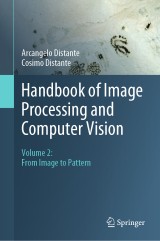Details

Handbook of Image Processing and Computer Vision
Volume 2: From Image to Pattern|
CHF 260.00 |
|
| Verlag: | Springer |
| Format: | |
| Veröffentl.: | 30.05.2020 |
| ISBN/EAN: | 9783030423742 |
| Sprache: | englisch |
Dieses eBook enthält ein Wasserzeichen.
Beschreibungen
<p>Across three volumes, the Handbook of Image Processing and Computer Vision presents a comprehensive review of the full range of topics that comprise the field of computer vision, from the acquisition of signals and formation of images, to learning techniques for scene understanding. The authoritative insights presented within cover all aspects of the sensory subsystem required by an intelligent system to perceive the environment and act autonomously. Volume 2 (From Image to Pattern) examines image transforms, image restoration, and image segmentation.</p><p>Topics and features:<br></p><p>• Describes the fundamental processes in the field of artificial vision that enable the formation of digital images from light energy<br></p><p>• Covers light propagation, color perception, optical systems, and the analog-to-digital conversion of the signal</p><p>• Discusses the information recorded in a digital image, and the image processing algorithms that can improve the visual qualities of theimage</p><p>• Reviews boundary extraction algorithms, key linear and geometric transformations, and techniques for image restoration</p><p>• Presents a selection of different image segmentation algorithms, and of widely-used algorithms for the automatic detection of points of interest</p><p>• Examines important algorithms for object recognition, texture analysis, 3D reconstruction, motion analysis, and camera calibration</p><p>• Provides an introduction to four significant types of neural network, namely RBF, SOM, Hopfield, and deep neural networks</p><p>This all-encompassing survey offers a complete reference for all students, researchers, and practitioners involved in developing intelligent machine vision systems. The work is also an invaluable resource for professionals within the IT/software and electronics industries involved in machine vision, imaging, and artificial intelligence.<br></p><p>Dr. Cosimo Distante is a Research Scientist in Computer Vision and Pattern Recognition inthe Institute of Applied Sciences and Intelligent Systems (ISAI) at the Italian National Research Council (CNR). Dr. Arcangelo Distante is a researcher and the former Director of the Institute of Intelligent Systems for Automation (ISSIA) at the CNR. His research interests are in the fields of Computer Vision, Pattern Recognition, Machine Learning, and Neural Computation.<br></p>
Local Operations: Edging.- Fundamental Linear Transforms.- Geometric Transformations.- Reconstruction of the Degraded Image: Restoration.- Image Segmentation.- Detectors and Descriptors of Interest Points.
<p><b>Dr. Cosimo Distante</b> is a Research Scientist in Computer Vision and Pattern Recognition in the Institute of Applied Sciences and Intelligent Systems (ISAI) at the Italian National Research Council (CNR).</p><p><b>Dr. Arcangelo Distante</b> is a researcher and the former Director of the Institute of Intelligent Systems for Automation (ISSIA) at the CNR. His research interests are in the fields of Computer Vision, Pattern Recognition, Machine Learning, and Neural Computation.<br></p>
<p>Across three volumes, the Handbook of Image Processing and Computer Vision presents a comprehensive review of the full range of topics that comprise the field of computer vision, from the acquisition of signals and formation of images, to learning techniques for scene understanding. The authoritative insights presented within cover all aspects of the sensory subsystem required by an intelligent system to perceive the environment and act autonomously. Volume 2 (From Image to Pattern) examines image transforms, image restoration, and image segmentation.</p><p>Topics and features:<br></p><p>• Describes the fundamental processes in the field of artificial vision that enable the formation of digital images from light energy<br></p><p>• Covers light propagation, color perception, optical systems, and the analog-to-digital conversion of the signal</p><p>• Discusses the information recorded in a digital image, and the image processing algorithms that can improve the visual qualities of theimage</p>• Reviews boundary extraction algorithms, key linear and geometric transformations, and techniques for image restoration</p><p>• Presents a selection of different image segmentation algorithms, and of widely-used algorithms for the automatic detection of points of interest</p><p>• Examines important algorithms for object recognition, texture analysis, 3D reconstruction, motion analysis, and camera calibration</p><p>• Provides an introduction to four significant types of neural network, namely RBF, SOM, Hopfield, and deep neural networks</p><p>This all-encompassing survey offers a complete reference for all students, researchers, and practitioners involved in developing intelligent machine vision systems. The work is also an invaluable resource for professionals within the IT/software and electronics industries involved in machine vision, imaging, and artificial intelligence.<br></p><p>Dr. Cosimo Distante is a Research Scientist in Computer Vision and Pattern Recognition in theInstitute of Applied Sciences and Intelligent Systems (ISAI) at the Italian National Research Council (CNR). Dr. Arcangelo Distante is a researcher and the former Director of the Institute of Intelligent Systems for Automation (ISSIA) at the CNR. His research interests are in the fields of Computer Vision, Pattern Recognition, Machine Learning, and Neural Computation.</p>
Presents truly comprehensive coverage of all aspects of computer vision and image processing Describes the fundamental processes underlying the acquisition of sensor data for the formation of a digital image Reviews the analysis and interpretation of image data, and the use of machine learning techniques Examines how an intelligent system may select the most appropriate actions to achieve its objectives, either autonomously or as part of a human–machine cooperative paradigm
Diese Produkte könnten Sie auch interessieren:

Mixed-Signal Layout Generation Concepts

von: Chieh Lin, Arthur H.M. van Roermund, Domine Leenaerts

CHF 118.00

System-Level Design Techniques for Energy-Efficient Embedded Systems

von: Marcus T. Schmitz, Bashir M. Al-Hashimi, Petru Eles

CHF 118.00














